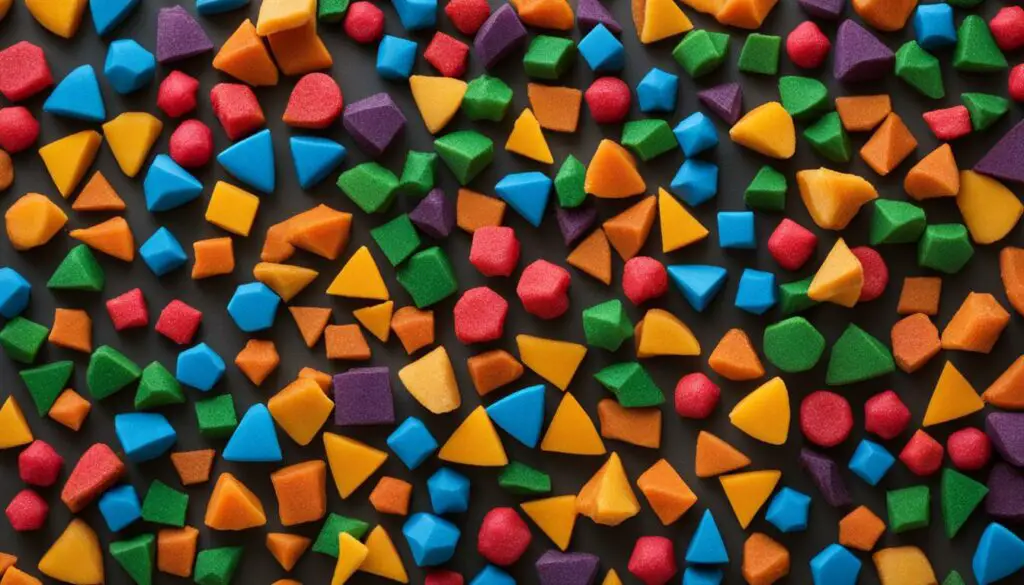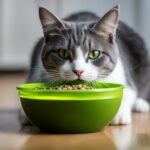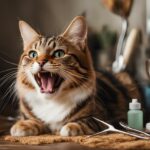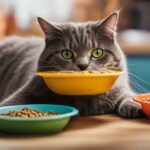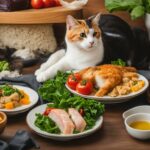As a cat owner, I’m always on the lookout for the best options to keep my furry friend healthy and happy. One important aspect of cat nutrition that I’ve discovered is the impact of dry cat food shapes. Yes, the shape of the kibble can make a difference in your cat’s eating experience and overall well-being.
There are various dry cat food shapes available in the market, each with its own unique qualities. Understanding these shapes can help you make informed decisions about the best options for your cat’s nutritional needs. From the classic round kibble to specialized shapes designed for specific purposes, it’s fascinating to dive into the world of cat food varieties and textures.
Key Takeaways:
- Dry cat food comes in a variety of shapes, each with its own impact on cat nutrition and eating experience.
- Understanding dry cat food shapes can help you choose the best options for your cat’s health and happiness.
- Consider your cat’s preferences and specific nutritional needs when selecting dry cat food.
- Different dry cat food shapes serve different purposes, such as dental health or promoting slower eating.
- Consult with your veterinarian to determine the most suitable dry cat food shape for your furry friend.
The Different Types of Cat Food
When it comes to feeding our feline friends, there are various types of cat food to choose from. Each type has its own unique characteristics, including different textures and moisture content, which can affect your cat’s eating experience and overall nutrition. Understanding these differences can help you make the best choice for your furry companion’s health and well-being.
One common type of cat food is wet food. This type typically comes in cans or pouches and has a high moisture content, making it more similar to a natural diet for cats. Wet food is often more palatable and can be easier to eat for cats with dental issues or who are prone to urinary tract problems. It also comes in a variety of flavors and textures, such as chunks in gravy or smooth pâté.
Another type of cat food is semi-moist food, which falls between wet and dry food in terms of moisture content. This type is often packaged in individual pouches and has a chewy texture that many cats find appealing. However, it’s important to note that semi-moist food can contain higher amounts of sugars, salts, and artificial additives, so it’s crucial to read the ingredients list carefully.
Table: Comparison of Cat Food Types
| Type of Cat Food | Texture | Moisture Content | Benefits |
|---|---|---|---|
| Wet Food | Chunks in gravy or smooth pâté | High | Palatable, easier to eat, variety of flavors |
| Semi-Moist Food | Chewy | Intermediate | Appealing texture, individual servings |
| Dry Biscuits | Crisp and crunchy | Low | Convenient, good for dental health, longer shelf life |
Lastly, there are dry biscuits, also known as kibble. This type of cat food has the lowest moisture content and is typically available in bags. Dry biscuits are convenient and have a longer shelf life compared to wet or semi-moist food. They can also help maintain dental health by promoting chewing and reducing plaque buildup. However, some cats may find dry biscuits less palatable, and it’s important to ensure they have access to fresh water to prevent dehydration.
Ultimately, the choice between these different types of cat food depends on your cat’s individual preferences, dietary needs, and any specific health concerns they may have. It’s important to consult with your veterinarian to determine the best option for your cat and to ensure they are receiving a balanced and nutritious diet.
The Pros and Cons of Dry Cat Food
Dry cat food, also known as kibble, offers both advantages and disadvantages for cat owners to consider. Here, we will explore the pros and cons of dry cat food, including its convenience, shelf life, ingredient quality, and potential drawbacks.
Pros of Dry Cat Food
One of the main benefits of dry cat food is its convenience. Unlike wet or semi-moist cat food, kibble can be left out for free-feeding, allowing your cat to graze throughout the day. This can be especially helpful for busy pet owners who may not always be available to feed their cats at specific times.
Another advantage is the longer shelf life of dry cat food. The low moisture content in kibble helps to preserve it for longer periods of time, reducing the risk of spoilage. This can be beneficial for households with multiple cats or for those who prefer to buy cat food in bulk.
Additionally, dry cat food is generally more affordable compared to other types of cat food. With a wide range of options available, pet owners can find high-quality kibble at various price points, making it accessible for different budgets.
Cons of Dry Cat Food
While dry cat food offers convenience and affordability, there are some potential downsides to consider. One concern is the quality of ingredients used in certain brands of dry cat food. Some lower-quality options may contain fillers, by-products, and artificial additives, which may not provide the optimal nutrition that cats need.
Furthermore, the palatability of dry cat food can vary. Some cats may not find kibble as appealing as wet or semi-moist food, which could lead to decreased food intake or selective eating. It’s important to choose high-quality dry cat food with ingredients that your cat enjoys to ensure they receive proper nutrition.
Lastly, storing dry cat food properly is crucial to maintain its nutritional value over time. Exposure to air, moisture, and heat can cause the food to deteriorate and lose its beneficial nutrients. It’s recommended to store dry cat food in a cool, dry place in an airtight container to preserve its freshness and quality.
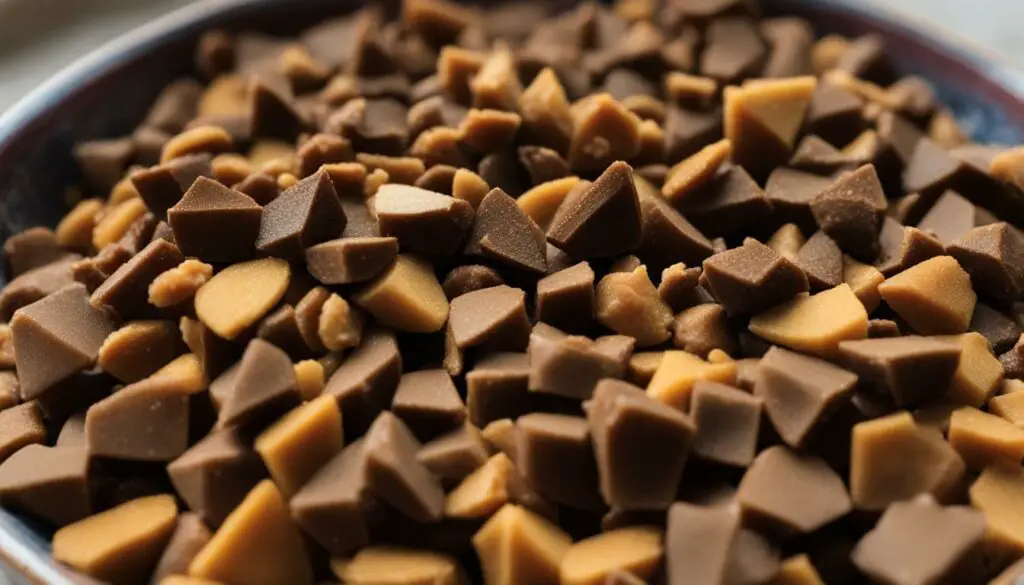
| Pros of Dry Cat Food | Cons of Dry Cat Food |
|---|---|
| Convenient for free-feeding | Potential lower quality of ingredients |
| Longer shelf life | Varied palatability for cats |
| Affordable | Proper storage is essential |
Understanding Semi-Moist Cat Food
Semi-moist cat food offers a middle ground between dry kibble and wet food. It has a higher moisture content than dry food, making it more palatable for some cats. However, it’s important to be aware of the potential drawbacks that come with this type of cat food.
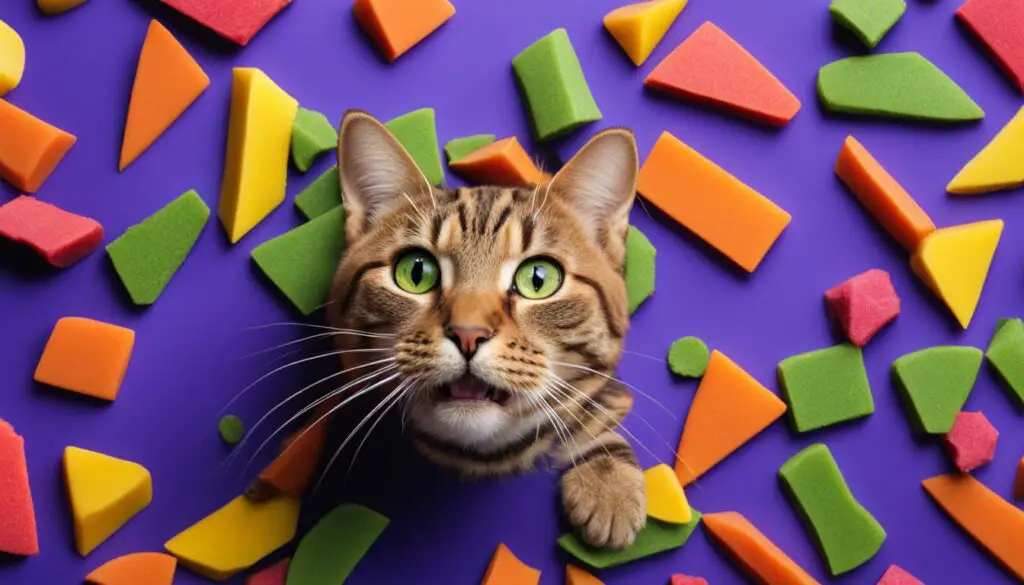
Semi-moist cat food is often formulated with additives and preservatives to maintain its texture and longer shelf life. These additives can include sugars, salts, and artificial flavors. While they help enhance the taste and texture of the food, they may not be the healthiest options for your cat.
When choosing semi-moist cat food, it is crucial to carefully read the ingredients list on the packaging. Look for high-quality cat food that uses natural and nutritious ingredients. Opt for options with real meat as the primary ingredient and avoid those with artificial additives and preservatives whenever possible.
Exploring Wet Cat Food
When it comes to wet cat food, there is a wide range of options available, each offering its own unique benefits. Wet cat food typically has a high moisture content, making it more palatable for cats and helping to keep them hydrated. It comes in various forms, including meat in gravy or jelly, flakes of fish in broth, or smooth pâté, allowing you to choose the texture that your cat prefers.
One important factor to consider when selecting wet cat food is the packaging. Look for cans or pouches that are easy to open and reseal, ensuring the freshness of the food and preventing waste. It is also essential to pay attention to the ingredients list and choose wet cat food that is made with high-quality ingredients, such as real meat or fish as the primary protein source, and avoid products that contain artificial additives or fillers.
Table:
| Brand | Flavor | Ingredients |
|---|---|---|
| Brand A | Chicken in Gravy | Chicken, Water, Gravy |
| Brand B | Tuna in Broth | Tuna, Fish Broth, Minerals |
| Brand C | Beef Pâté | Beef, Liver, Water, Carrageenan |
Quotes:
“My cat absolutely loves the wet food with real pieces of fish in it. It’s like a special treat for her!” – Cat Owner
“I always make sure to choose wet cat food that is made with high-quality ingredients. It gives me peace of mind knowing that I’m providing my cat with wholesome nutrition.” – Cat Owner
By selecting high-quality wet cat food that appeals to your cat’s taste buds and is made with healthy ingredients, you can ensure that your furry friend is getting the nourishment they need while enjoying their meals.
The Importance of Choosing the Right Cat Food
When it comes to cat nutrition, selecting the right food plays a crucial role in your feline friend’s overall health and well-being. The quality of cat food, including the ingredients used and the nutritional content, directly impacts your cat’s vitality and longevity.
Ensuring that your cat’s diet contains high-quality ingredients is essential. Look for cat foods that prioritize animal protein sources, as cats are obligate carnivores and require meat for optimal health. Avoid cat foods with long ingredient lists, artificial additives, and unfamiliar substances.
Cat food preferences are also important to consider. Just like humans, cats have individual tastes and preferences when it comes to food flavors. Observing your cat’s response to different food options can help you determine their favorites, making mealtime a more enjoyable experience for both you and your feline companion.
Choosing the Right Cat Food: Key Considerations
When selecting cat food, there are several factors to keep in mind:
- Cat nutrition: Prioritize cat foods that provide a balanced and complete diet, meeting your cat’s specific nutritional needs.
- Cat food quality: Opt for cat foods made with high-quality ingredients and minimal fillers or by-products.
- Cat food ingredients: Read the ingredient list carefully, avoiding cat foods with artificial preservatives, flavors, or colors.
- Cat food preferences: Consider your cat’s individual taste preferences when selecting food flavors, ensuring they enjoy their meals.
By taking these factors into account and consulting with your veterinarian, you can make informed decisions about your cat’s diet, promoting their overall health and happiness.
The Importance of Choosing the Right Cat Food
Choosing the right cat food is crucial for your cat’s overall health and well-being. Consider their natural diet as obligate carnivores and prioritize animal protein and fat sources. Avoid cat foods with long ingredient lists, artificial additives, and unfamiliar ingredients. Pay attention to your cat’s preferences and consult with your veterinarian for specific recommendations.
| Key Considerations for Choosing Cat Food |
|---|
| Cat nutrition |
| Cat food quality |
| Cat food ingredients |
| Cat food preferences |
By considering these factors and selecting high-quality cat food, you can ensure that your furry friend receives the necessary nutrients for a healthy and happy life.
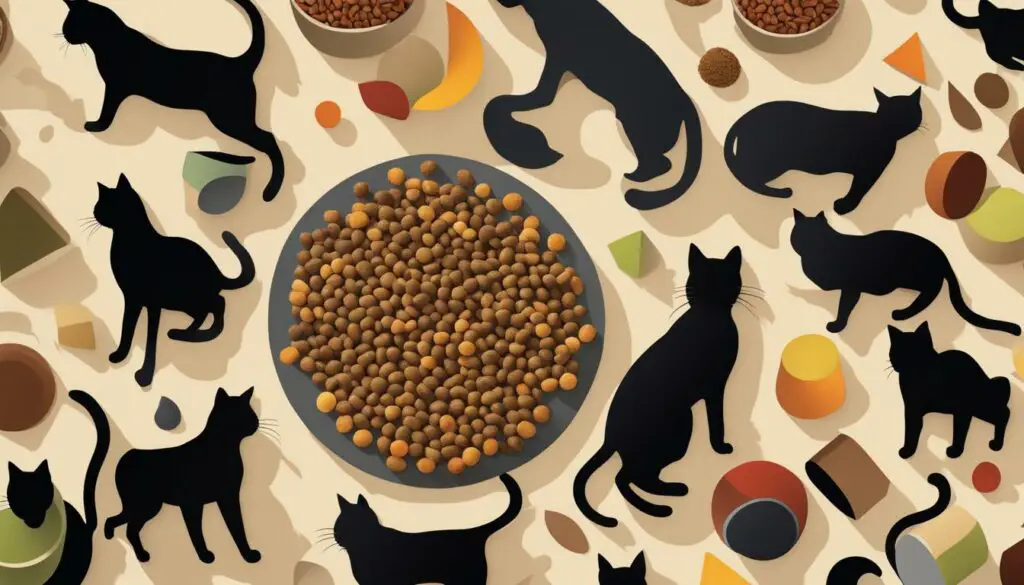
The Impact of Cat Food on Dental Health
When it comes to cat dental health, there is a common misconception that dry cat food helps clean teeth. However, this belief is not entirely accurate. Cats have limited mastication ability and tend to swallow kibble whole, reducing any abrasive effect on teeth. While chewing on dry food may provide some minimal scraping action, it is not sufficient to effectively remove plaque and tartar buildup.
Dental care for cats should be a separate consideration from the type of cat food you choose. Regular teeth brushing and dental check-ups are essential for maintaining your cat’s oral hygiene. There are specially formulated dental treats and toys available that can help promote dental health by encouraging chewing and providing some mechanical cleaning action.
Proper dental care, including regular veterinary check-ups and teeth brushing, is crucial for maintaining your cat’s dental health. Choosing the right cat food alone is not enough to prevent dental issues.
Keep in mind that dental disease can still occur even if your cat consumes dry food. Some cats are more prone to dental issues due to their genetics or other factors. If your cat has a history of dental problems or if you notice any signs of discomfort, such as difficulty chewing or bad breath, consult your veterinarian for proper evaluation and treatment.
| Dental Health Tips for Cats |
|---|
| 1. Regular teeth brushing with cat-specific toothpaste |
| 2. Provide dental treats or toys that promote chewing |
| 3. Schedule regular dental check-ups with your veterinarian |
| 4. Observe your cat’s eating habits and look out for signs of dental issues |
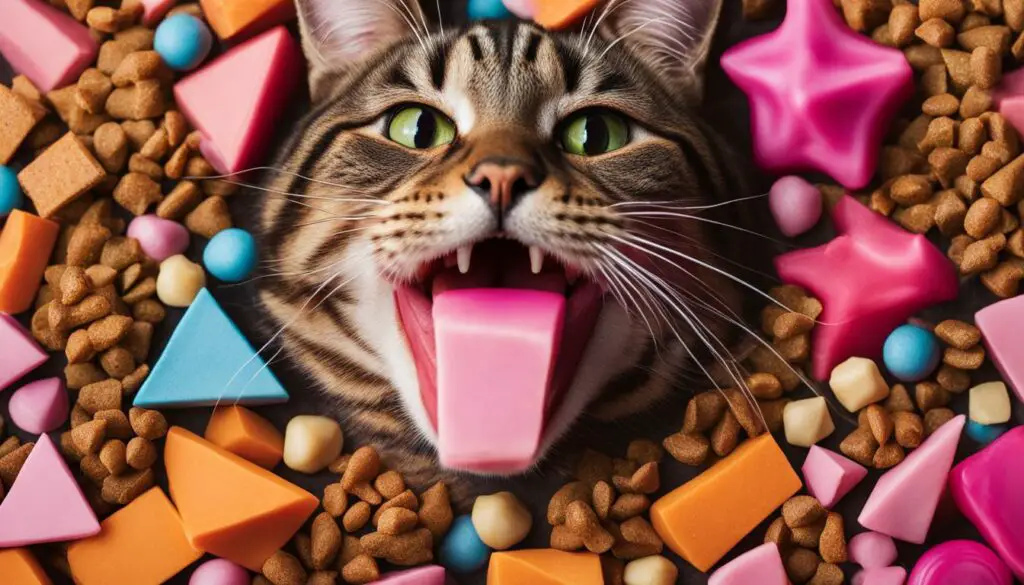
In conclusion, while dry cat food may not have a significant impact on dental health, it is important to prioritize dental care through regular brushing, veterinary check-ups, and appropriate dental toys or treats. Remember to pay attention to your cat’s individual needs and consult your veterinarian for personalized recommendations to ensure optimal dental health.
Dry Cat Food and Dehydration
Dry cat food, also known as kibble, has a low moisture content which can contribute to dehydration in cats. Cats have a low thirst drive, meaning they don’t naturally consume as much water as they need. When cats rely solely on dry food, they may not drink enough water to compensate for the lack of moisture in their diet.
Dehydration can lead to various health issues, including urinary tract diseases. It’s important to take steps to prevent dehydration in cats and promote proper hydration. One way to do this is by providing fresh water at all times and encouraging your cat to drink. Some cats prefer running water, so you may consider investing in a cat water fountain to entice them to drink more. Additionally, incorporating wet or raw food into your cat’s diet can help increase their overall moisture intake.
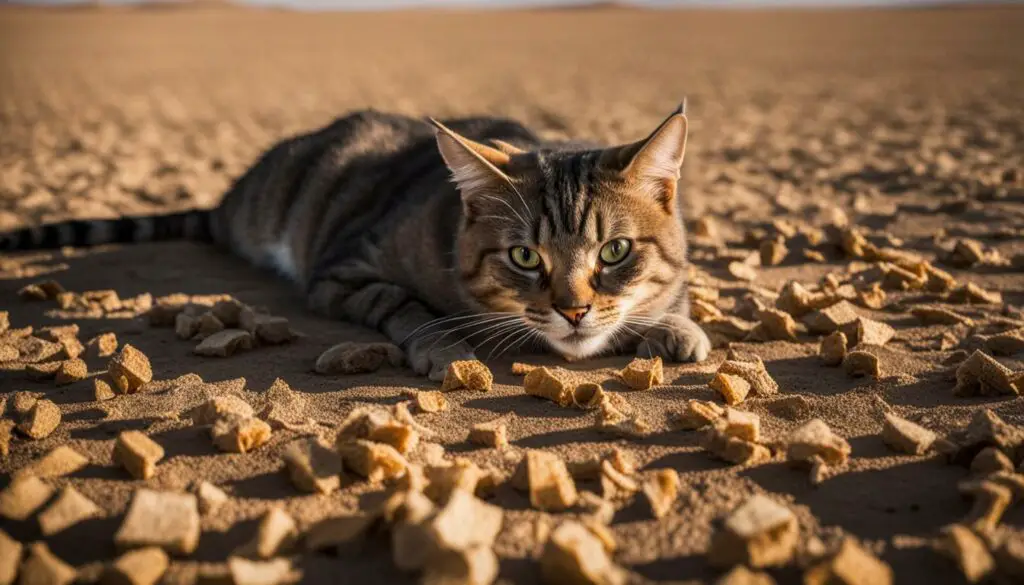
When choosing dry cat food, it’s important to consider your cat’s hydration needs. Look for kibbles that have a higher moisture content or are specifically formulated to promote hydration. You can also moisten dry cat food with water or low-sodium broth to increase its moisture content.
By prioritizing your cat’s hydration and incorporating wet or raw food into their diet, you can help prevent dehydration and promote their overall health and well-being.
Understanding the Link Between Dry Cat Food and Feline UTI
When it comes to choosing the right cat food for our furry friends, we must consider not only their taste preferences but also their overall health. Recent studies have revealed a concerning link between dry cat food and feline urinary tract infection (UTI). While dry food may be convenient and have a longer shelf life, its low moisture content and high carbohydrate content can contribute to the development of UTIs in cats.
The low moisture content of dry cat food can lead to dehydration in cats, which can further increase the risk of UTIs. Cats have low thirst drives and may not drink enough water to compensate for the lack of moisture in their food. Switching to a high-moisture diet, such as wet or raw food, can help prevent the recurrence of UTIs and promote better urinary health in cats.
It’s important to note that not all dry cat foods are created equal. Some brands offer formulas that are specifically designed to promote urinary tract health, containing ingredients that support a healthy pH balance and prevent the formation of urinary crystals and stones. Consulting with your veterinarian and carefully reading the ingredients list can help you choose a dry cat food that minimizes the risk of UTIs while providing complete and balanced nutrition for your feline companion.
| Dry Cat Food and Feline UTI | Key Points |
|---|---|
| Low moisture content | Increases the risk of dehydration and urinary tract infections |
| High carbohydrate content | Can contribute to urinary issues in cats |
| Choose high-moisture alternatives | Wet or raw food can help prevent UTIs and promote urinary health |
| Look for specialized formulas | Some dry cat foods are designed to support urinary tract health |
As responsible cat owners, it’s essential to prioritize our feline companions’ well-being by making informed choices about their diet. By understanding the link between dry cat food and feline UTIs, we can take proactive measures to minimize the risk and promote optimal urinary health for our beloved cats.
Quote:
“Switching to a high-moisture diet, such as wet or raw food, can help prevent the recurrence of UTIs and promote better urinary health in cats.” – Veterinarian
How Cat Food Shapes Affect Eating Experience
When it comes to feeding our feline friends, the shape of cat food plays a significant role in their eating experience and feeding behavior. Different shapes can have various effects on how cats consume their food and can even impact their overall enjoyment of mealtime.
Cats are known for their natural hunting instincts, and their unique eating behavior reflects this. Small, round kibble shapes mimic the size and texture of prey, encouraging cats to use their teeth to crunch and chew. This not only provides mental stimulation but also helps promote dental health by reducing plaque and tartar buildup.
“The shape of cat food can influence cats’ feeding behavior and may affect their preference for certain food types.”
On the other hand, some cats may have preferences for specific shapes based on their individual eating habits and mouth structure. For example, flat-shaped kibble may be easier for cats with dental issues or smaller mouths to pick up and chew. Additionally, some cats may prefer softer, irregularly shaped food that can be easily broken apart or mashed with their paws before eating.
Ultimately, understanding your cat’s feeding behavior and preferences can help you choose the most suitable shape of cat food for them. Observing how they interact with different shapes and monitoring their overall enjoyment of mealtime can guide you in providing a rewarding and satisfying eating experience.
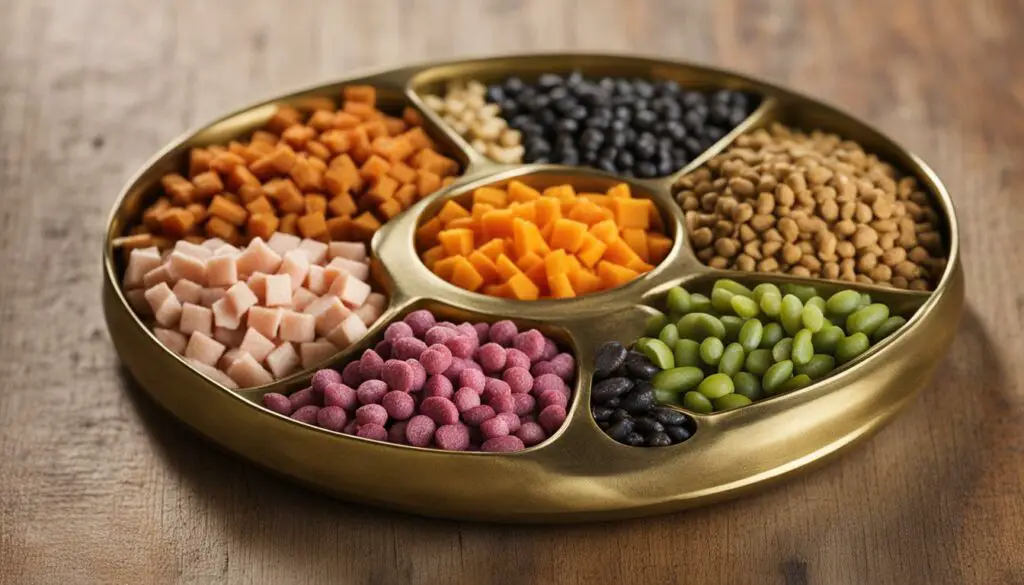
| Shape | Feeding Behavior | Benefits |
|---|---|---|
| Small, round kibble | Crunching and chewing | Promotes dental health |
| Flat-shaped kibble | Easier for cats with dental issues or smaller mouths | Allows easy picking and chewing |
| Soft, irregularly shaped food | Mashing or breaking apart with paws | Suitable for cats with texture preferences or specific eating habits |
Conclusion
The shape of cat food can significantly impact your cat’s eating experience and feeding behavior. Considering your cat’s dental health, mouth structure, and individual preferences can guide you in selecting the most suitable shape of cat food. Whether it’s small, round kibble for dental health or softer, irregularly shaped food for texture preferences, providing a variety of shapes can make mealtime more enjoyable for your feline companion.
The Role of Animal Protein, Fat, and Nutrients in Cat Food
Cats require a diet rich in animal protein, animal fat, and essential nutrients to thrive. Animal protein is crucial for their overall health and well-being. It provides essential amino acids necessary for muscle growth, coat maintenance, and organ function. When choosing cat food, it is important to prioritize high-quality animal protein sources to meet your cat’s nutritional needs.
Animal fat is another essential component of a cat’s diet. It serves as a source of energy and provides essential fatty acids that contribute to healthy skin and a shiny coat. Including adequate amounts of animal fat in your cat’s diet is crucial for their overall health and vitality.
In addition to animal protein and fat, cat food should also contain a balanced blend of essential nutrients. These nutrients include vitamins, minerals, and antioxidants, which are necessary for a cat’s immune system, digestion, and overall well-being. Choosing cat food with high-quality ingredients ensures that your cat receives the necessary nutrients to support their optimal health.
| Nutrient | Role |
|---|---|
| Animal Protein | Essential for muscle growth, coat maintenance, and organ function |
| Animal Fat | Source of energy and provides essential fatty acids |
| Essential Nutrients | Vitamins, minerals, and antioxidants necessary for immune system, digestion, and overall well-being |
When selecting cat food, it is important to consider the quality of the ingredients. Look for cat foods that feature real animal protein sources, such as chicken, turkey, or fish, as the first ingredients. Avoid cat foods that contain excessive fillers, additives, or artificial preservatives. Reading the ingredient list and understanding the quality of the ingredients will help ensure that your cat receives a nutritionally balanced diet.
Remember, each cat is unique, and their nutritional needs may vary. It’s always a good idea to consult with your veterinarian to determine the best cat food options for your furry friend. By providing a diet rich in animal protein, animal fat, and essential nutrients, you can help support your cat’s optimal health and well-being.
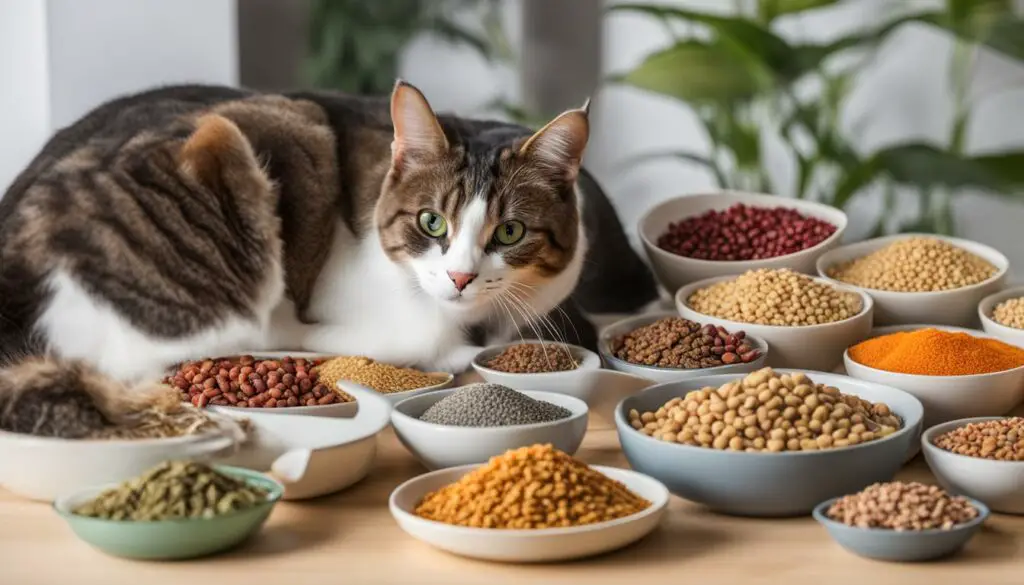
Choosing the Perfect Cat Food Flavor and Variant
When selecting cat food for your furry friend, it’s essential to consider their preferences. Cats have individual tastes, and finding the right flavor can make a significant difference in their enjoyment of mealtime. However, it’s important to navigate the world of cat food marketing and labels to ensure you’re making the best choice for your cat’s health.
To begin, take a closer look at cat food labels. phrases like “flavored with” or “made with” may indicate a lower percentage of the named ingredient. It’s crucial to consult the ingredients list and choose cat food with a high percentage of the named protein source. This ensures that your cat is getting the nutritional benefits they need.
“Choosing the right cat food flavor and variant is more than just a matter of taste. It’s about making sure your cat receives the proper nutrition they need for optimal health and well-being.”
When it comes to marketing, be wary of gimmicks and catchy phrases that may not reflect the actual quality of the cat food. Look for brands that prioritize high-quality ingredients and avoid artificial additives and fillers. Your cat’s health should always take precedence over clever marketing tactics.
Table: Comparison of Cat Food Flavors and Nutritional Content
| Brand | Flavor | Percentage of Named Protein Source | Additional Nutritional Information |
|---|---|---|---|
| Brand A | Chicken | 90% | Rich in vitamins and minerals |
| Brand B | Chicken “Flavored With” | 60% | Includes artificial flavors and fillers |
| Brand C | Chicken and Fish | 85% | High in omega-3 fatty acids |
Remember, selecting the perfect cat food flavor and variant goes beyond satisfying your cat’s taste buds. It’s about providing them with the necessary nutrients for their overall well-being. By understanding labels, being mindful of marketing tactics, and considering your cat’s nutritional needs, you can make an informed choice that ensures your cat stays healthy and happy.
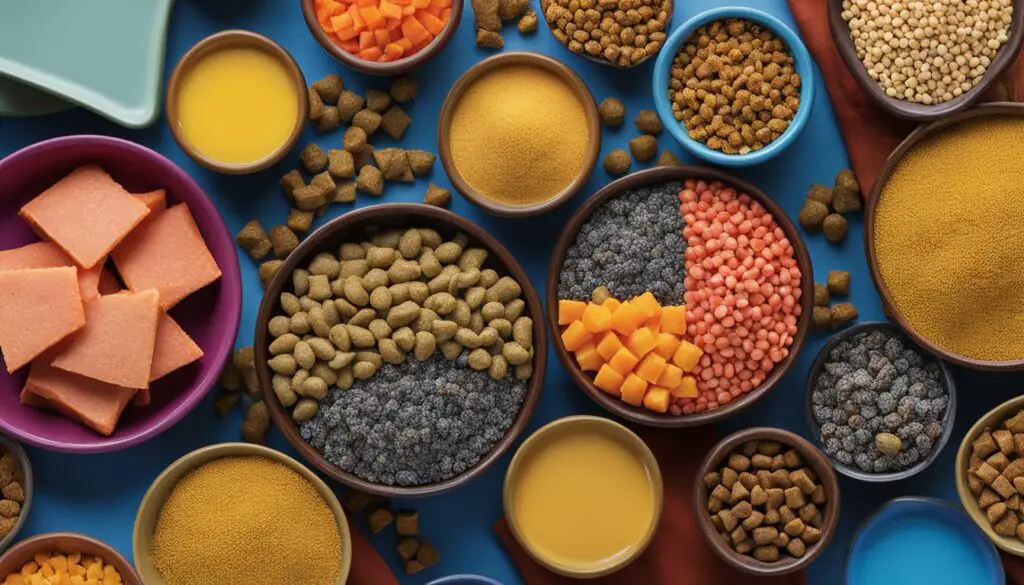
Conclusion
After exploring the different shapes and types of dry cat food, it is evident that understanding these options is vital for your cat’s nutrition and overall health. By considering your cat’s individual preferences, dietary needs, and potential health issues, you can make informed choices about their food.
When selecting cat food, prioritize high-quality ingredients and consult with your veterinarian for specific recommendations. Pay attention to your cat’s response to different food options and adjust accordingly. By providing a balanced and appropriate diet, you can ensure your cat’s well-being and happiness.
Remember that cat nutrition plays a significant role in their overall health. Opt for cat food with high animal protein and fat sources, as cats require these nutrients for muscle growth, coat maintenance, and organ function. Take into account that cat food flavors may vary, but be cautious of labeling conventions and choose high-quality options with a high percentage of the named protein source.
Ultimately, your cat’s health should be the main priority. By understanding the impact of dry cat food shapes, exploring various cat food options, and considering their nutritional needs, you can provide them with the best diet tailored to their individual requirements. With proper nutrition, your cat can thrive and enjoy a happy, healthy life.
FAQ
What is the difference between wet, semi-moist, and dry cat food?
Wet cat food has a high moisture content and comes in various forms such as meat in gravy or jelly, flakes of fish in broth, or smooth pâté. Semi-moist cat food has a higher moisture content than dry cat food and is often more palatable. Dry cat food, also known as kibble, is convenient and has a longer shelf life.
Are all dry cat foods the same?
No, dry cat foods can vary in terms of quality and nutritional value. It is important to choose high-quality dry cat food that contains animal protein and fat sources and avoid those with high carbohydrate content and artificial additives.
Does dry cat food help clean teeth?
No, the belief that dry cat food cleans teeth is a common misconception. Cats have limited mastication ability and tend to swallow kibble whole, reducing any abrasive effect on teeth. Regular dental care, such as teeth brushing and dental check-ups, is important for maintaining dental health.
Can dry cat food lead to dehydration?
Yes, dry cat food has a low moisture content, which can contribute to dehydration in cats. Cats have low thirst drives and may not drink enough water to compensate for the lack of moisture in dry food. It is important to provide fresh water and incorporate wet or raw food into your cat’s diet to prevent dehydration.
Is there a link between dry cat food and urinary tract infections (UTIs)?
Yes, studies have shown a link between dry cat food consumption and feline urinary tract infections. Dry food’s low moisture content and high carbohydrate content can contribute to UTIs in cats. Switching to a high-moisture diet, such as wet or raw food, can help prevent UTIs and promote better urinary health.
How does the shape of cat food impact my cat’s eating experience?
The shape of cat food can affect your cat’s eating behavior and preferences. Some cats may have preferences for certain shapes, while others may find it more challenging to eat food with specific shapes. It is important to observe your cat’s eating behavior and choose the best shape of cat food for their individual needs.
What should I prioritize when choosing cat food?
When choosing cat food, prioritize high-quality ingredients, including animal protein and fat sources. Avoid cat foods with long ingredient lists, artificial additives, and unfamiliar ingredients. Consult with your veterinarian and pay attention to your cat’s preferences to select the best cat food for their nutritional needs.
How can I ensure my cat’s overall health and happiness?
Providing a balanced and appropriate diet is crucial for your cat’s overall health and happiness. Consider your cat’s natural diet as an obligate carnivore and prioritize animal protein and fat sources. Choose high-quality cat food, pay attention to their preferences, and consult with your veterinarian for specific recommendations.
Source Links
- https://www.wildernesscat.com/everything-need-know-dry-cat-food/
- https://vcahospitals.com/know-your-pet/dry-canned-or-semi-moist-food-choices-for-cats
- https://www.untamedcatfood.com/blogs/nutrition/types-of-cat-food

